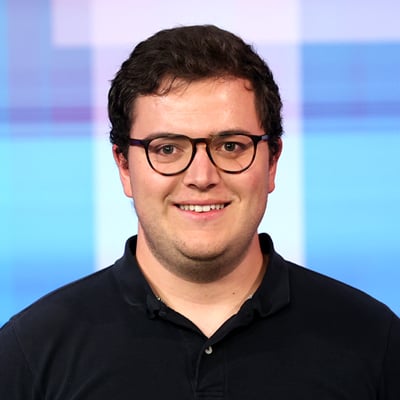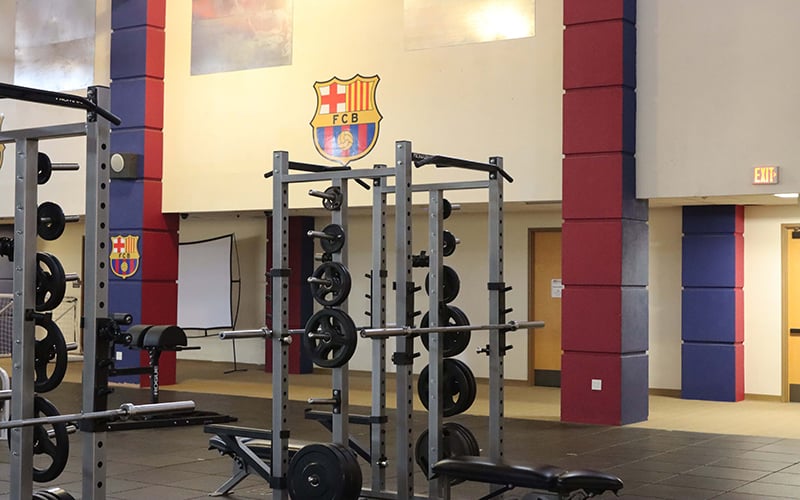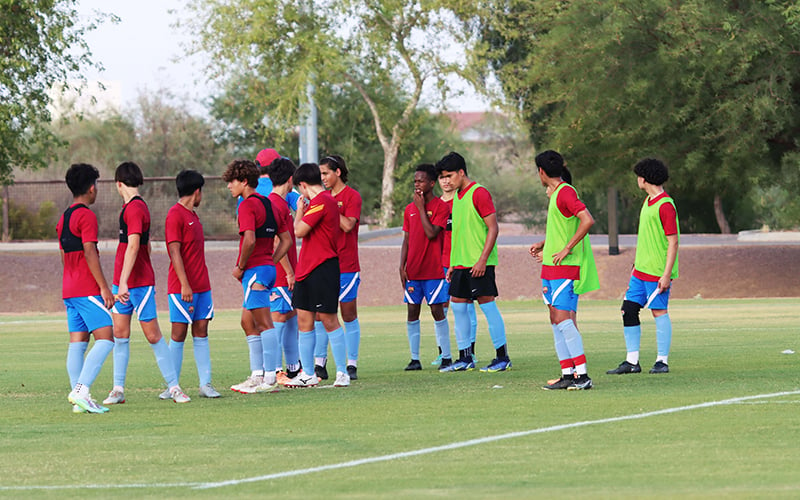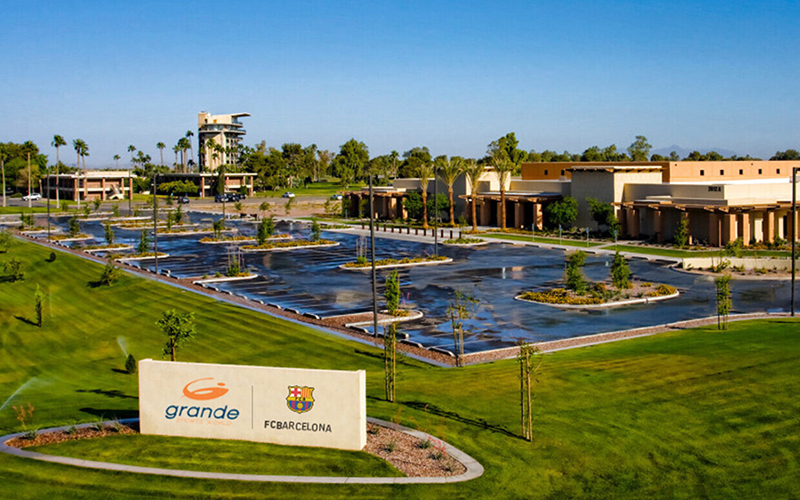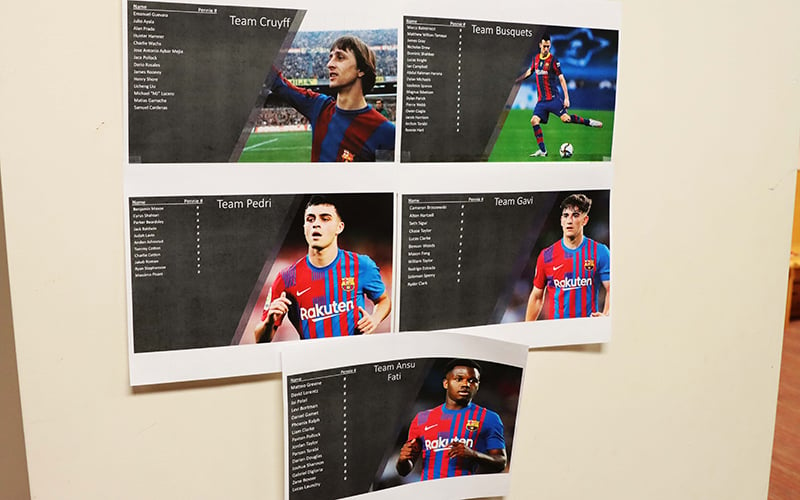CASA GRANDE – Fútbol Club Barcelona is one of the best-known soccer clubs in the world, with various Champions League, World Cup and LaLiga titles. However, it is also recognized for producing historic talent, as the names of Leo Messi, Andrés Iniesta, Xavi Hernández, Gerard Piqué, Carles Puyol or even the recent Ansu Fati or Gavi prove.
This factory of superstars is called “La Masia” – which takes it name from aristocratic houses in Catalonia – and it achieves its goal through a very specific process: Young players, some beginning as early as 6, move away from their families and live in a dorm-style facility to study and train.
Since 2016, FC Barcelona has now a second “La Masia” in Casa Grande: the Barça Academy and Residency USA, which takes the exact same approach as the one in Spain.
However, paths in Europe and the United States are different. Most European youth aspire to sign a professional contract as early as possible and try to keep that path for their entire careers. Leo Messi, for example, made his debut when he was 16.
On the other hand, most U.S. players first consider college and then try to turn professional. Because academics are part of that journey, ASU Prep Academy has a presence at the Casa Grande facilities.
The home of the Barça Academy is the Grande Sports World, which has on-site dorms, eight soccer fields and a 58,000 square foot state-of-the-art athletic training facility. It is introduced by a building in which classes, weight rooms and locker rooms are located. At the center of the building is the weight room, surrounded by FC Barcelona’s logo.
The ASU Prep Academy can be accessed through a double door, which leads to a different wing with a Hall of Fame and a variety of classrooms. A door opposite the entrance opens to training grounds and multiple fields.

The Barça Academy has two full-time trainers that take care of players while they are on campus. (Photo by Marcos Grada Martinez/Cronkite News)
In this case, the Barça Academy mixes both approaches and provides its graduates an environment that will allow them to choose the path they want. All students so far have left the academy with a collegiate offer or a professional contract (most often in the MLS), according to their website.
“Largely, (the reason why 100% of graduates either go to college or professionally) is due to our successes that attracts the best players,” said Tim Alai, Barça Academy general manager.
That success is achieved because of a specific methodology.
“We have a staff of 135 that are on property that help support and administer the program, we have two coaches from FC Barcelona that work with the coaches and the players on the methodology, and the curriculum,” Alai said. “So they have the best environment, the best coaches, the best facilities and the best education that is available to provide that. So that environment produces those types of results.”
Luca Sowinski is an example of a student who traveled away from home – he was born in San Diego – to enroll at the Academy and commit to an NCAA program: the University of Denver.
“I think there’s a lot of benefits,” Sowinski said. “On one hand, at soccer I’ve certainly seen myself grow as a player. We have the most talented players and the best coaches around. So certainly as a player I’ve grown but also as a person. It’s a really good experience to be able to meet a lot of people and learn a lot of things.”
Apart from their marquee players, FC Barcelona is also famous for its soccer style. The late Johan Cruyff started that mentality at Barça, putting style in front of the results, and it proved profitable, as he built the Dream Team and in 1992 won the first Champions League for the club.
In 2008, that style developed even more when Barça appointed Pep Guardiola as the head coach. With him, players including Sergio Busquets or Pedrito made their debut with the first team, and FC Barcelona won the first-ever treble, winning the three major trophies, in the history of Spain.
That was achieved through that playing style, holding the ball more than their rivals (most games would end up with Barça having more than 70% of possession), with a high pressure off the turnover and hundreds of passes per game, usually at first touch.
That style became very recognizable, and it even had a nickname, the tiki-taka, and it has been Barça’s signature. That is why, in the Casa Grande academy, they develop their players with the same idea, thanks to the assistance of two full-time Spanish coaches who live at Casa Grande and came from La Masia.
“The guys from FCB that come in … they really work with not only the coaches, but the players as well, to really implement what was before,” U19 coach Ged Quinn said. “Every drill that we do is designed with that in mind: You’re looking for the different advantages that we can have on the field looking to maintain possession, we want to make sure that we can dominate the ball, we can dominate the possession and we can dictate the player.”
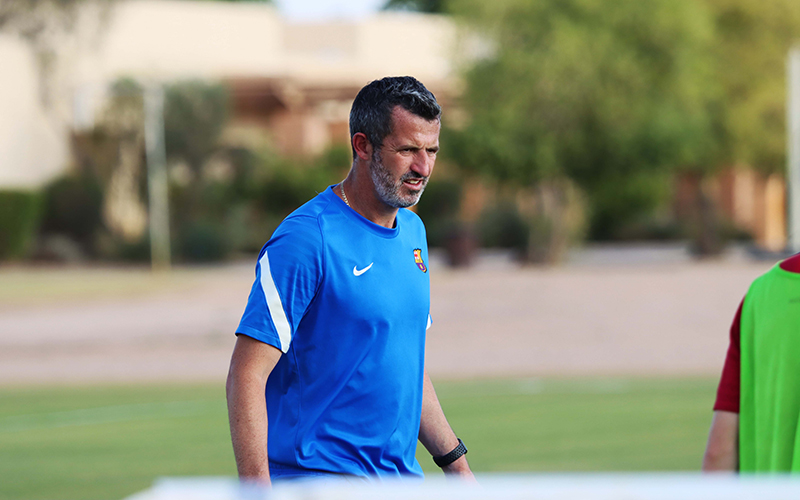
Ged Quinn is from the Northeast of England. He moved to Arizona five years ago, and is the Barça Academy U19 coach. (Photo by Marcos Grada Martinez/Cronkite News)
One of the main features of that style is that it forces opposing teams to run after the ball while trying to recover it, which becomes very tiring and something FC Barcelona coaches see as an advantage. To implement that style may be a slow process, but that is a sacrifice Barça Academy coaches are willing to make.
“We find in Arizona, especially with the heat, we want to have the ball because the last thing you want to be doing is chasing after it in 100-degree weather,” Quinn said. “We may lose some games at the (90th minute) and that’s fine because ultimately for us if we’re playing the way we want to play, our thought process is that we will win more games than we lose.”
For most soccer players in the U.S., enrolling in the Academy seems like an obvious decision. However, it is not that simple.
Apart from paying $75,900 tuition to live on-site, if they chose, players have to either be recruited or try out. It’s a system that was already built in 2011 as a Real Salt Lake City academy before FC Barcelona took over.
Once there, another challenge presents itself: homesickness. Iniesta, one of Barça’s greatest legends and the player who scored an extra-time game winner at the 2010 World Cup Final to give Spain its only global title, confessed in several interviews that he could not stop crying for days, even weeks, when he was taken to La Masia at 12 years old.
“We have a full support team here that has awesome residential staff,” Quinn said. “There are seven or eight people that live on-site with the boys. So they’re here as support staff. We have a full-time counselor that’s available for the boys mental wellness—they can schedule meetings with her. And then obviously, the coaches are available for a bit of extra support as well.”
For those who struggle, the best help is to find friends who can support them through the same process. For instance, Iniesta became close friends with Dani Jarque, who passed away during the summer of 2009. Iniesta honored him at that World Cup by revealing a tank top with the words “Dani Jarque, Siempre Con Nosotros” (Dani Jarque, Always With Us).
“I think my favorite part, honestly, is just the people I’ve been able to meet here,” Sowinski said. “There’s kids from everywhere in the country, even outside the country. I think my favorite part has just been meeting them, getting to know them, learning everything about them. I’ll be friends with them for the rest of my life, hopefully. So that’s been really, really special.”
